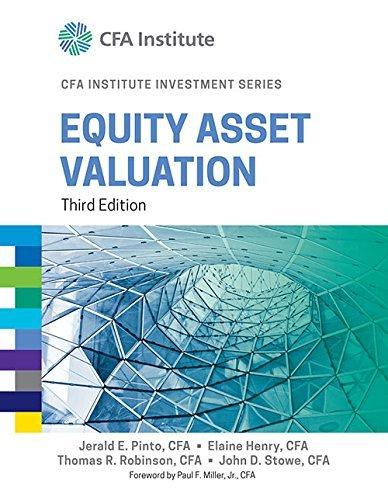On 21 September 2000, Intel Corporation (NASDAQ -GS: INTC)3 issued a press release containing information about its
Question:
On 21 September 2000, Intel Corporation (NASDAQ -GS: INTC)3 issued a press release containing information about its expected revenue growth for the third quarter of 2000. The announced growth fell short of the company’s own prior prediction by 2 to 4 percentage points and short of analysts’ projections by 3 to 7 percentage points. In response to the announcement, Intel’s stock price fell nearly 30 percent during the following five days—from \($61.50\) just prior to the press release to only \($43.31\) five days later.
To assess whether the information in Intel’s announcement was sufficient to explain such a large loss of value, Cornell (2001) estimated the value of a company’s equity as the present value of expected future cash flows from operations minus the expenditures needed to maintain the company’s growth. (We will discuss such free cash flow models in detail in a later reading.)
Using a conservatively low discount rate, Cornell estimated that Intel’s price before the announcement, \($61.50\), was consistent with a forecasted growth rate of 20 percent a year for the subsequent 10 years and then 6 percent per year thereafter. Intel’s price after the announcement, \($43.31\), was consistent with a decline of the 10-year growth rate to well under 15 percent per year. In the final year of the forecast horizon (2009), projected revenues with the lower growth rate would be \($50\) billion below the projected revenues based on the pre-announcement price. Because the press release did not obviously point to any changes in Intel’s fundamental long-run business conditions (Intel attributed the quarterly revenue growth shortfall to a cyclical slowing of demand in Europe), Cornell’s detailed analysis left him skeptical that the stock market’s reaction could be explained in terms of fundamentals.
Assuming Cornell’s methodology was sound, one interpretation is that investors’
reaction to the press release was irrational. An alternative interpretation is that Intel’s stock was overvalued prior to the press release, and the press release was “a kind of catalyst that caused movement toward a more rational price, even though the release itself did not contain sufficient long-run valuation information to justify that movement”
(Cornell 2001, p.134). How could one evaluate these two possible interpretations?
Step by Step Answer:






